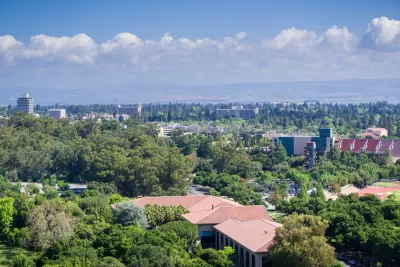Palo Alto could designate more than one hundred properties as historic in an attempt to prevent lot splitting permitted under a new state law designed to lightly increase residential density.

"Since SB9 went into effect this year, affluent communities across California are in the midst of trying to implement the new state lot-splitting law aimed at increasing the number of new homes as officials continue to battle homelessness and the worst unaffordability in the country." Aldo Toledo reports on one effort to skirt the law using historic preservation.
SB9 was passed as an attempt to address California's worsening housing crisis, but as we noted in a prior post, cities around the state have proposed a variety of creative measures to circumvent the law's density requirements. In Palo Alto, "City staff is currently sitting on a 20-year-old study that identified 165 properties and a handful of unique city districts eligible for historic preservation which it has yet to list on any register." According to Toledo's article, "City officials say new commercial buildings, mid-century modern structures and historic homes and districts already surveyed as eligible for the historic registry could be added to the city’s landmark list, which would further limit where Senate Bill 9 can apply in Palo Alto."
Other cities have landed in hot water for similar attempts. "On Tuesday, California Attorney General Rob Bonta notified the city of Pasadena that its attempt to broadly exempt neighborhoods from SB9 requirements by declaring them 'landmark districts' violates state law." And in a highly publicized case last month, the Silicon Valley town of Woodside briefly considered exempting the entire community from SB9 as protected mountain lion habitat, a proposal widely criticized and which the city quickly retreated from.
FULL STORY: Palo Alto council could use historic preservation to skirt SB9 lot-splitting law

Study: Maui’s Plan to Convert Vacation Rentals to Long-Term Housing Could Cause Nearly $1 Billion Economic Loss
The plan would reduce visitor accommodation by 25,% resulting in 1,900 jobs lost.

North Texas Transit Leaders Tout Benefits of TOD for Growing Region
At a summit focused on transit-oriented development, policymakers discussed how North Texas’ expanded light rail system can serve as a tool for economic growth.

Why Should We Subsidize Public Transportation?
Many public transit agencies face financial stress due to rising costs, declining fare revenue, and declining subsidies. Transit advocates must provide a strong business case for increasing public transit funding.

How to Make US Trains Faster
Changes to boarding platforms and a switch to electric trains could improve U.S. passenger rail service without the added cost of high-speed rail.

Columbia’s Revitalized ‘Loop’ Is a Hub for Local Entrepreneurs
A focus on small businesses is helping a commercial corridor in Columbia, Missouri thrive.

Invasive Insect Threatens Minnesota’s Ash Forests
The Emerald Ash Borer is a rapidly spreading invasive pest threatening Minnesota’s ash trees, and homeowners are encouraged to plant diverse replacement species, avoid moving ash firewood, and monitor for signs of infestation.
Urban Design for Planners 1: Software Tools
This six-course series explores essential urban design concepts using open source software and equips planners with the tools they need to participate fully in the urban design process.
Planning for Universal Design
Learn the tools for implementing Universal Design in planning regulations.
City of Santa Clarita
Ascent Environmental
Institute for Housing and Urban Development Studies (IHS)
City of Grandview
Harvard GSD Executive Education
Toledo-Lucas County Plan Commissions
Salt Lake City
NYU Wagner Graduate School of Public Service





























